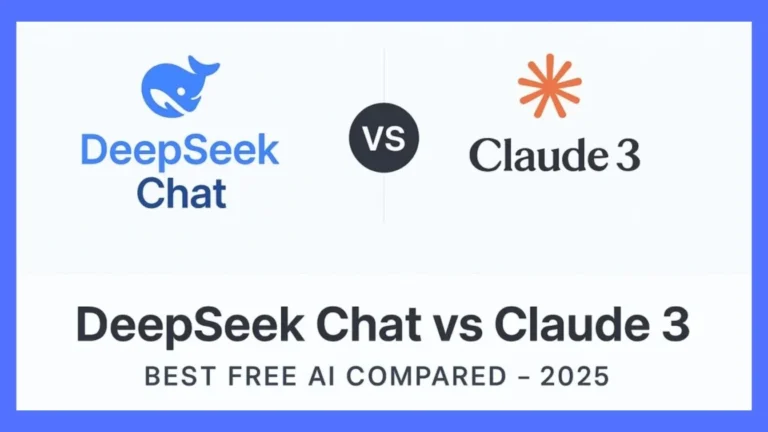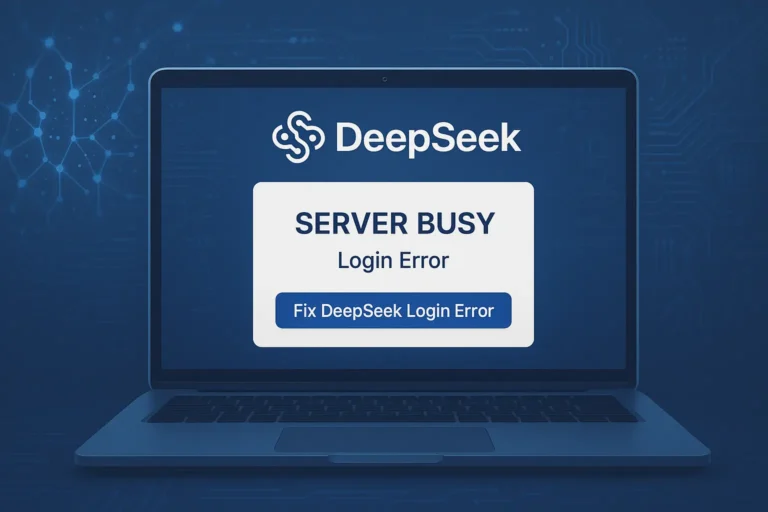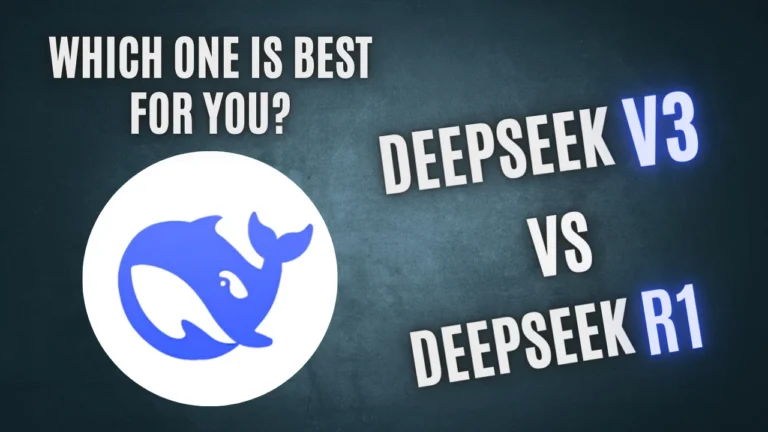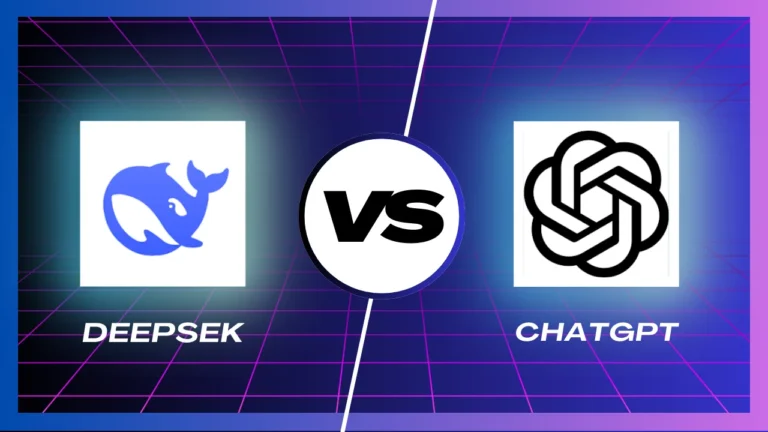Qwen 3 vs DeepSeek: Which AI Model Performs Better in Real Use Cases?
If you’re wondering who wins in the battle of Qwen 3 vs DeepSeek, you’re not alone—we tested both models in various real-world use cases to find out which one truly delivers. While DeepSeek AI has been known for its reasoning and multilingual capabilities, Qwen 3 is gaining attention for smoother natural language understanding and efficient handling of user prompts. In this post, we’ll walk through performance tests, compare outputs, and share what we found when putting both models to the test. This isn’t theory—it’s what we tried ourselves, and the results were eye-opening.
Read Also: DeepSeek vs ChatGPT, Gemini & Grok: Compare the Best AI Chatbots of 2025
What is DeepSeek?
DeepSeek is an advanced large language model (LLM) developed with a focus on high accuracy, code generation, and academic-style content. It’s designed to understand complex prompts and generate reliable outputs, especially in professional and educational contexts.
Key Features of DeepSeek:
- High factual accuracy: Great at sticking to real information, especially useful in research and technical writing.
- Strong code generation: Produces clean, bug-free code in popular languages like Python, JavaScript, and more.
- Academic writing support: Excels in summarizing, paraphrasing, and writing in formal tones.
- Multilingual understanding: Supports various languages with a focus on clarity and precision.
- Reliable performance: Often consistent and less prone to hallucinations in structured tasks.
What is Qwen 3?
Qwen 3 is a next-generation language model created by Alibaba’s Institute for Intelligent Computing. It’s part of the Qwen series and is known for its fast responses, conversational fluency, and multilingual strength—making it great for both general and creative tasks.
Key Features of Qwen 3:
- Natural language flow: Excellent for casual, creative, and human-like conversations.
- Speedy generation: Quick at handling complex prompts and generating responses with low latency.
- Advanced multilingual support: Performs impressively in many languages, especially in informal and native-style dialogues.
- Conversational strength: Great for chatbots, story writing, and idea generation.
- Balanced performance: Handles both general-purpose tasks and creative use cases efficiently.
Real Use Case Tasks: Content Writing, Code Generation, and Chatbot Conversations
To truly compare Qwen 3 vs DeepSeek, we put both models through practical, everyday AI tasks—just like the ones creators, developers, and businesses run regularly.
1. Content Writing
We gave both models identical writing prompts, such as generating blog intros, product descriptions, and listicle-style content. Qwen 3 stood out for its smooth flow, tone consistency, and readability. DeepSeek, however, offered more factual depth and slightly better coherence on longer articles, especially in topics requiring technical accuracy.
2. Code Generation
Next, we tested them on Python, JavaScript, and HTML tasks. DeepSeek AI was more consistent in returning correct and complete code for complex problems. Qwen 3 was faster and offered cleaner formatting but occasionally missed subtle syntax rules unless prompted twice.
3. Chatbot Conversations
For natural dialogue, we simulated customer support and educational Q&A scenarios. Here, Qwen 3 excelled—its answers felt more human-like, with better contextual memory and less robotic repetition. DeepSeek was still reliable, especially when the focus was on structured or step-by-step responses.

Speed and Efficiency: Qwen 3 vs DeepSeek
When it comes to speed and efficiency, the differences between Qwen 3 vs DeepSeek become more noticeable during real-time testing.
Prompt Speed
Qwen 3 consistently felt snappier when handling complex prompts. Whether we were generating multi-paragraph blog content, solving coding problems, or simulating chatbot interactions, its responses arrived quickly and required less waiting time between outputs.
Factual Consistency
On the other hand, DeepSeek proved to be more stable in delivering factually accurate responses. While it sometimes took slightly longer to respond—especially with detailed technical queries—it was more likely to get the correct answer on the first try, especially in research-heavy or data-focused tasks.
Overall, if you’re in a rush and need content quickly, Qwen 3 is your friend. But for tasks where precision matters, DeepSeek holds its ground.
Understanding Context: Qwen 3 vs DeepSeek
When evaluating Qwen 3 vs DeepSeek on how well they understand and maintain context, both models show impressive capabilities—but with different strengths.
Contextual Flow in Conversations
Qwen 3 shines when it comes to maintaining a natural and flowing conversation. In casual dialogue and creative writing tasks, it remembers user inputs better and builds on them smoothly. It feels more human-like in back-and-forth interactions, making it ideal for chatbots or long-form storytelling.
Handling Academic Prompts
However, DeepSeek pulls ahead in structured and academic-style prompts. Whether you’re drafting technical explanations, summarizing research, or writing essays with proper citations and tone, DeepSeek delivers more focused and coherent content. It stays on-topic and avoids drifting off into unrelated ideas.
So, while Qwen 3 feels more conversationally intelligent, DeepSeek brings a disciplined edge to tasks that require deeper structure and academic clarity.
When to Use Which Model: Qwen 3 vs DeepSeek
Choosing between Qwen 3 vs DeepSeek depends on what you’re trying to accomplish. Each model has its strengths, and picking the right one for the task can make a big difference.
For Creative Writing and Conversations
If you’re writing stories, brainstorming ideas, or building chatbots, Qwen 3 is the better pick. Its natural flow and engaging tone make it great for anything that feels conversational or imaginative.
For Factual Accuracy and Academic Work
When it comes to fact-based writing, summarizing research, or completing academic tasks, DeepSeek stands out. It’s more precise, structured, and tends to stay on-topic without hallucinating too often.
For Multilingual Tasks
Both models support multiple languages, but Qwen 3 seems to have a stronger grip on informal and idiomatic expressions in languages like Chinese, Spanish, and French. DeepSeek performs well in formal translations and structured multilingual outputs.
For Code Generation and Technical Tasks
It’s a close call here. DeepSeek generates cleaner, more reliable code with fewer errors, especially for Python and data-related tasks. Qwen 3, on the other hand, is faster in generating snippets but may require more editing.
Choose Qwen 3 for creativity, conversation, and flexible multilingual tasks. Pick DeepSeek for accuracy, structured writing, and coding reliability. Both models are powerful, but knowing when to use which can help you get the best results from your AI tools.
Quick Look: Qwen 3 vs DeepSeek
| Task Type | Qwen 3 Strength | DeepSeek Strength | Verdict |
|---|---|---|---|
| Creative Writing | Smooth flow, engaging tone, fast generation | Structured writing, slightly more factual | Qwen 3 for style, DeepSeek for precision |
| Conversational AI | Human-like dialogue, strong context retention | Clear, logical responses, slightly formal | Qwen 3 is better for natural chat |
| Code Generation | Fast snippets, clean format | Accurate, bug-free logic, better on complex tasks | DeepSeek is more reliable for production-level code |
| Academic Writing | Decent formal tone | High factual accuracy, formal tone, great for research writing | DeepSeek is the clear winner here |
| Multilingual Tasks | Strong in informal, native-like expressions | Clear in formal multilingual writing | Qwen 3 for informal, DeepSeek for formal content |
| Speed & Latency | Faster response time, efficient with prompts | Slightly slower but more accurate | Qwen 3 if speed matters |
| Factual Accuracy | Good, but may occasionally hallucinate | High consistency, rarely off-topic | DeepSeek if correctness is essential |
LLM Benchmark: Qwen vs DeepSeek
When it comes to LLM benchmarks, both Qwen 3 and DeepSeek have proven themselves capable in different areas. Here’s how they compare based on public benchmarks and practical evaluation:
General Knowledge and Reasoning
- Qwen 3 excels in conversational reasoning, especially in open-ended questions and multilingual tasks.
- DeepSeek performs better in structured reasoning tasks like mathematics, science, and factual QA — showing strong alignment with academic benchmarks like MMLU and CMMLU.
Code Generation
- DeepSeek ranks higher on code-focused benchmarks such as HumanEval and MBPP.
- It produces clean, readable code, while Qwen 3 is faster but may need refinement on complex logic tasks.
Language and Context Handling
- Qwen 3 often scores better in natural dialogue benchmarks like MT-Bench and Chatbot Arena.
- Its fluency and contextual understanding feel more human-like in casual or creative prompts.
There’s no one-size-fits-all winner. Choose Qwen 3 for creative, multilingual, and conversational tasks. Choose DeepSeek for coding, academic writing, and accuracy-focused prompts.
Conclusion:
So—Qwen 3 vs DeepSeek, who wins? Honestly, it depends on what you’re doing. If your use case leans toward casual conversation, storytelling, or general-purpose chatbots, Qwen 3 shines with its natural flow and responsiveness. But for research-heavy prompts, multilingual support, or structured reasoning tasks, DeepSeek still holds a strong edge. We enjoyed testing both and saw real strengths in each. Hopefully, our side-by-side AI model performance test helped you figure out which is better for your own needs. Let us know what you’re using—and keep exploring these amazing LLMs with us.







